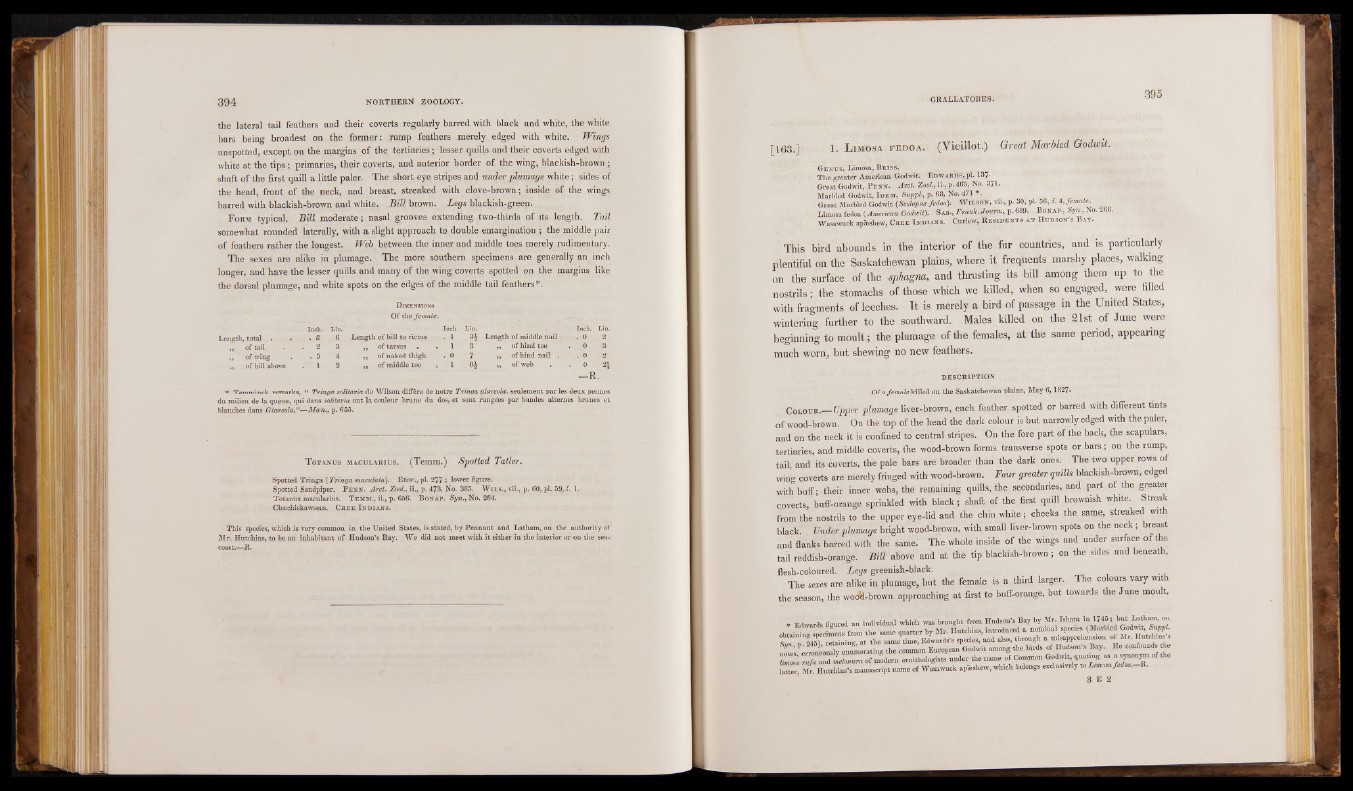
the lateral tail feathers and their coverts regularly barred with black and white, the white
bars being broadest on the former: rump feathers merely edged with white. Wings
unspotted, except on the margins of the tertiaries; lesser quills and their coverts edged with
white at the tips; primaries, their coverts, and anterior border of the wing, blackish-brown ;
shaft of the first quill a little paler. The short eye stripes and under plumage white; sides of
the head, front of the neck, and breast, streaked with clove-brown; inside of the wings
barred with blackish-brown and white. Bill brown. Legs blackish-green.
F orm typical. Bill moderate; nasal grooves extending two-thirds of its length. Tail
somewhat rounded laterally, with a slight approach to double emargination ; the middle pair
of feathers rather the longest. Web between the inner and middle toes merely rudimentary.
The sexes are alike in plumage. The more southern specimens are generally an inch
longer, and have the lesser quills and many of the wing coverts spotted on the margins like
the dorsal plumage, and white spots on the edges of the middle tail feathers*.
Dimensions
Of the female.
Inch. Lin. " Inch. Lin. - Inch. Lin.
Length; total . . . 8 .6 Length of bill to rictus . 1 3^ Length of middle nail . 0 2
„ of tail . . 2 3 „ of tarsus . . 1 3 „ of hind toe . 0 3
„ of wing . . 5 4 „ o f naked thigh . 0 7 „ of hind nail . . 0 2
- „ - of bill above . 1 2 „ o f middle toe . 1 0$ „ of web . . 0 2f —R.
* Temminck remarks, “ Tringa solitaria de Wilson diffère de notre Tringa glareola, seulement par les deux pennes
du milieu de la queue, qui dans solitaria ont la couleur brune du dos, et sont rangées par bandes alternes brunes et
blanches dans Glareola.”—Man., p. 655.
T otanus macularius. (Temm.) Spotted Tatter.
Spotted Tringa ( Tringa maculata). Edw., pi. 277 » lower figure.
Spotted Sandpiper. Penn. Arct. Zool., ii., p. 473, No. 385. Wils., vii., p. 60, pi. 59, f. 1.
Totanus macularius. Temm., ii., p. 666. Bonap. Syn., No. 264.
Chsechiskawsees. Ce.ee . Indians.
This species, which is very common in the United States, is stated, by Pennant and Latham, on the authority of
Mr. Hutchins, to be an inhabitant of Hudson’s Bay. We did not meet with it either in the interior or on the sea-
[163.] 1- L im o sa f e d o a . (Vieillot.) Great Marbled Godwit.
TGheen gurse,a Lteirm Aomsae, rBicmans sG. odwit. Edwards, pi. 13/.
Great Godwit, Penn. Arct. Zool., ii., p. 465, No. 371.
Marbled Godwit, Idem, Suppl., p. 68, No. 471 *.
Great Marbled Godwit (Scolopax fedoa); W il so n , vii., p. 30, pi. 56, f. 4, female.
Limosa. fedoa (American Godwit). S in , Frank. Jowm., p. 689. Bonap., Syn., No. 266.
Wasawuck apssshew, Chee I ndians. Curlew, Residents at Hudson s Bat.
This bird abounds in the interior of the fur countries, and is particularly
plentiful on the Saskatchewan plains, where it frequents marshy places, walking
on the surface of the sphagna, and thrusting its bill among them up to the
nostrils; the stomachs of those which we killed, when so engaged, were filled
with fragments of leeches. It is merely a bird of passage in the United States,
wintering further to the southward. Males killed on the 21st of June were
beginning to moult; the plumage of the females, at the same period, appearing
much worn, but shewing no new feathers.
DESCRIPTION
Of a female killed on the Saskatchewan plains, May 6,1827.
Colour.— C/pper plumage liver-brown, each feather spotted or barred with different tints
of wood-brown. On the top of the head the dark colour is but narrowly edged with the paler,
and on the neck it is confined to central stripes. On the fore part of the back, the scapulars,
tertiaries, and middle coverts, the wood-brown forms transverse spots or bars; on the rump,
tail, and its coverts, the pale bars are broader than the dark ones. The two upper rows of
wing coverts are mereLy fringed with wood-brown. Four greater quills blackish-brown, edged
with buff; their inner webs, the remaining quills, the secondaries, and part of the greater
coverts, buff-orange sprinkled with black; shaft of the first quill brownish white. Streak
from the nostrils to the upper eye-lid and the chin white ; cheeks the same, streaked with
black. Under plumage bright wood-brown, with small liver-brown spots on the neck; breast
and flanks barred with the same. The whole inside of the wings and under surface of the
tail reddish-orange. Bill above and at the tip blackish-brown ; on the sides and beneath,
flesh-coloured. Legs greenish-black. .
The sexes are alike in plumage, but the female is a third larger. The colours vary with
the season, the woJS-brown approaching at first to buff-orange, but towards the June moult,
» Edwards Bgured an individual which was brought from Hndson’s Bay by Mr. Isham m 1745; but Latham, on
obtaining specimens from the same quarter by Mr. Hutohins, introduced a nominal species (Marbled Godwit, Suppl.
Son n 2451 retaining, at the same time, Edwards’s species, and also, through a misapprehension of Mr. Hutchins s
S B y the common Europemi Godwit among the birds of Hudson's Bay. He confounds he
of modern ornithologists under the name of Common Godwit qnoung as a synonym of the
letter ^H u tc h in s's manuscript name of Wasawuck apftshew, which belongs exclusively to Lmora fedm .-R .
3 E 2